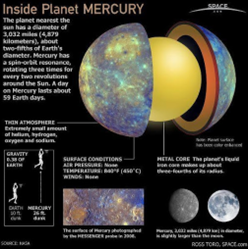TAG: GS-3: SCIENCE & TECHNOLOGY
CONTEXT: September 8, 2024, BepiColombo made its closest approach to Mercury, capturing sharp black-and-white images of its surface.
EXPLANATION:
About the Mercury:

Mercury is the closest planet to the Sun, orbiting at an average distance of 57.9 million km. Due to this proximity, it experiences extreme temperatures.
Size & Structure:
- It is the smallest planet in the Solar System, with a diameter of about 4,880 km.
- Mercury has a large metallic core (comprising about 85% of the planet’s radius) and a relatively thin silicate mantle and crust.
Temperature Extremes:
- Mercury’s surface experiences drastic temperature variations:
- Daytime temperatures: up to 430°C.
- Nighttime temperatures: as low as -180°C.
Surface and Geological Features:
- Mercury has a heavily cratered surface, similar to the Moon. It has numerous impact craters due to the lack of a substantial atmosphere to protect it from space debris.
- The planet features large basins such as the Caloris Basin, formed by ancient impacts.
- The presence of scarps (cliffs) indicates that Mercury’s surface has contracted as its core cooled over time.
Orbital and Rotational Characteristics:
- Mercury has an elliptical orbit and takes 88 Earth days to complete one revolution around the Sun.
- It rotates very slowly, taking 59 Earth days to complete one rotation on its axis. This creates a phenomenon where one day (from sunrise to sunrise) on Mercury lasts about 176 Earth days.
- Mercury experiences no axial tilt, which means it lacks seasons.
Atmosphere:
- Mercury has an extremely thin and tenuous atmosphere, called an exosphere, composed of oxygen, sodium, hydrogen, helium, and potassium.
- This exosphere is constantly being replenished due to the interaction of the solar wind with the planet’s surface.
What is a BepiColombo Mission:
BepiColombo is a joint mission between the European Space Agency (ESA) and the Japan Aerospace Exploration Agency (JAXA), launched in 2018. Its main goal is to study Mercury.
- The spacecraft is set to orbit Mercury by 2026, following a series of flybys of Earth, Venus, and Mercury to gradually slow down its velocity.
- BepiColombo has two more flybys scheduled for December 2024 and January 2025.
- After these, it will spend two years orbiting the Sun before finally reaching its orbit around Mercury.
Major missions to Mercury:
- Mariner 10 (1974-1975) – NASA
- Objective: First mission to fly by Mercury and study its surface and atmosphere.
- MESSENGER (2004-2015) – NASA
- Objective: Study Mercury from orbit, focusing on its surface, atmosphere, and magnetic field.
- BepiColombo (2018-Present) – ESA & JAXA
- Objective: A joint mission by the European Space Agency (ESA) and the Japan Aerospace Exploration Agency (JAXA) to study Mercury’s surface, exosphere, magnetosphere, and interior.
- Study Mercury’s ‘surface composition’, structure, and geological history.
- Investigate Mercury’s magnetic field and magnetosphere.
- Map the distribution of volatile elements like water ice in permanently shadowed regions.
Significance
- The mission aims to explore Mercury’s composition, geology, magnetic field, and its origins.
- Studying peak ring basins will help to understand
- the planet’s ancient volcanism and ongoing geological activity.
- The mission also seeks to understand how Mercury’s large core, volatile-rich composition, and the presence of water ice on its surface can exist despite its proximity to the Sun.
Source:
Spread the Word
